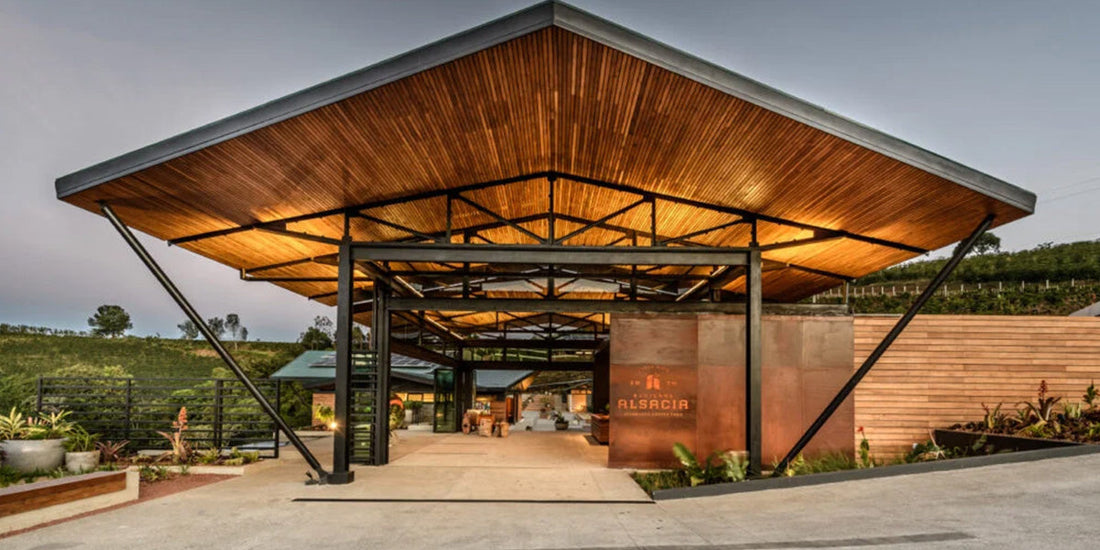
Inside Starbucks Costa Rica Coffee Farm Hacienda Alsacia
Share
If you're into coffee, you’ve probably heard about Hacienda Alsacia. This farm marks a major shift for Starbucks—owning and operating its own coffee farm in Costa Rica. It’s where they grow beans, test new agricultural methods, and share what they learn with coffee producers around the world.
Let’s break down what makes this farm different, from its origin story to how it connects to your morning brew.
How It All Started
Starbucks bought Hacienda Alsacia in 2013. At the time, coffee farmers were struggling, especially with leaf rust wiping out crops across Latin America. Starbucks wanted a research hub to study those problems up close—and find real solutions.
They chose this spot on the slopes of Poás Volcano, a region already known for top-notch beans. It’s Starbucks’ only company-run farm, covering 240 hectares and more than 800,000 coffee trees.
Before this, Starbucks didn’t own land. They sourced coffee globally. Alsacia changed that. It became a test ground for disease-resistant plants and better farming techniques. They’ve since shared those breakthroughs with farmers worldwide.
In 2018, they added a visitor center, inviting coffee lovers to see the farm firsthand. It turned from a research lab into a place to learn, explore, and sip coffee at the source.
Location and Coffee Varieties
Hacienda Alsacia is in Sabanilla, Alajuela province—less than an hour from San José. Volcanic soil and elevation (1,200–1,600 meters) make it ideal for growing arabica beans.
What They Grow
They cultivate several varieties adapted to local conditions:
| Variety | Key Traits | Processing Method |
|---|---|---|
| Caturra | Compact, high yield | Washed |
| Villa Sarchi | Rust-resistant, bright acidity | Washed or sun-dried |
| Costa Rica 95 | Disease-resistant hybrid | Washed |
They also experiment with new hybrids, trying to strike a balance between disease resistance and cup quality.
The farm includes:
-
A tree nursery
-
A wet mill
-
Drying patios
-
A roaster
Everything happens on-site—from cherry to bag.
The Coffee Production Process
Harvest runs from November to March. Workers hand-pick ripe cherries. Next comes depulping (removing the outer layer), followed by fermentation, washing, and drying—either in the sun or by machine.
They try different processing methods:
-
Sun-drying for sweetness
-
Washed for clarity in flavor
Small batches get roasted for quality checks. You’ll find some of these beans in limited-edition Starbucks Reserve bags or brewed in select cafés.
Flavor Profiles
-
Washed (medium roast): Citrus, milk chocolate
-
Sun-dried: Dried plum, molasses
-
Decaf: Naturally processed to retain flavor
It’s not a high-volume operation. It’s focused on quality and learning.
Sustainability at the Core
Hacienda Alsacia is built around long-term sustainability, both for the land and the people working it.
What They’re Doing:
| Practice | Benefit |
|---|---|
| Shade-grown trees | Protect biodiversity |
| Water recycling systems | Reduce consumption |
| Disease-resistant hybrids | Reduce chemical usage |
| Drone monitoring | Improve precision and efficiency |
They reuse by-products as compost and keep water use low. Techniques developed here are shared globally via Starbucks’ 10 Farmer Support Centers.
They also run training programs for women farmers, helping with both agricultural and business skills.
In 2024, Starbucks expanded its research efforts by buying:
-
A nearby Costa Rican farm for drone/ag-tech trials
-
A new Guatemala farm for more varietal testing
Plan Your Visit
You can visit any day, 8 a.m. to 6 p.m.
Tour Options
-
90-minute guided tour ($30): Nursery, wet mill, drying patios, and roaster—with tastings along the way
-
45-minute Coffee Lab: Focused on brewing techniques
The on-site café serves fresh Alsacia brews with a view of the fields. Pastries, sandwiches, and espresso drinks round out the menu.
Getting there: Drive from San José or take a bus to Alajuela, then a short taxi ride. It’s near Poás Volcano, so it pairs well with a visit to the crater.
Tours often book out—reserve ahead on their site.
In 2024, the farm hosted the Latin America Barista Championship, bringing together top talent from the region.
Starbucks Reserve Connection
You’ll find Hacienda Alsacia beans in Starbucks Reserve offerings—small-batch coffees roasted and served at Roastery locations in Seattle, Milan, New York, and more.
Expect bright acidity, citrus, and chocolate notes.
The farm also inspires merchandise: mugs, tote bags, and more featuring Alsacia artwork.
At Reserve cafés, beans are brewed using siphon, pour-over, and other manual methods—highlighting the farm’s flavors.
Brewing Hacienda Alsacia Coffee with a Traditional Chorreador
Want to drink this coffee like locals do? Use a chorreador, Costa Rica’s iconic pour-over stand with a cloth filter (or "sock").
What You Need
-
Chorreador stand
-
Cotton filter (rinse first)
-
Medium-coarse ground coffee
-
Hot water (around 200°F)
-
Mug or carafe
Steps to Brew
| Step | Action | Tip |
|---|---|---|
| 1 | Rinse filter | Removes residue and preheats filter |
| 2 | Set up stand | Add 1–2 tbsp grounds per 6 oz water |
| 3 | Heat water | Stop just before boiling (200°F) |
| 4 | Bloom coffee | Pour a little, wait 30 seconds |
| 5 | Pour slowly | Use a circular motion |
| 6 | Let drip and enjoy | Stir lightly, enjoy black or sweetened |
After use, rinse the filter with water only and hang it to dry. Replace every few months.
This simple tool draws out the clean, bright notes of Hacienda Alsacia beans beautifully.
Final Thoughts
Hacienda Alsacia isn’t just a farm—it’s Starbucks’ living lab. A place to grow, experiment, and share. Whether you visit in person or just sip the beans from a Reserve bag, you’re getting a taste of innovation rooted in Costa Rican soil.
Want to connect even deeper? Brew it with a chorreador. It’s one of the simplest—and most Costa Rican—ways to enjoy your coffee.
